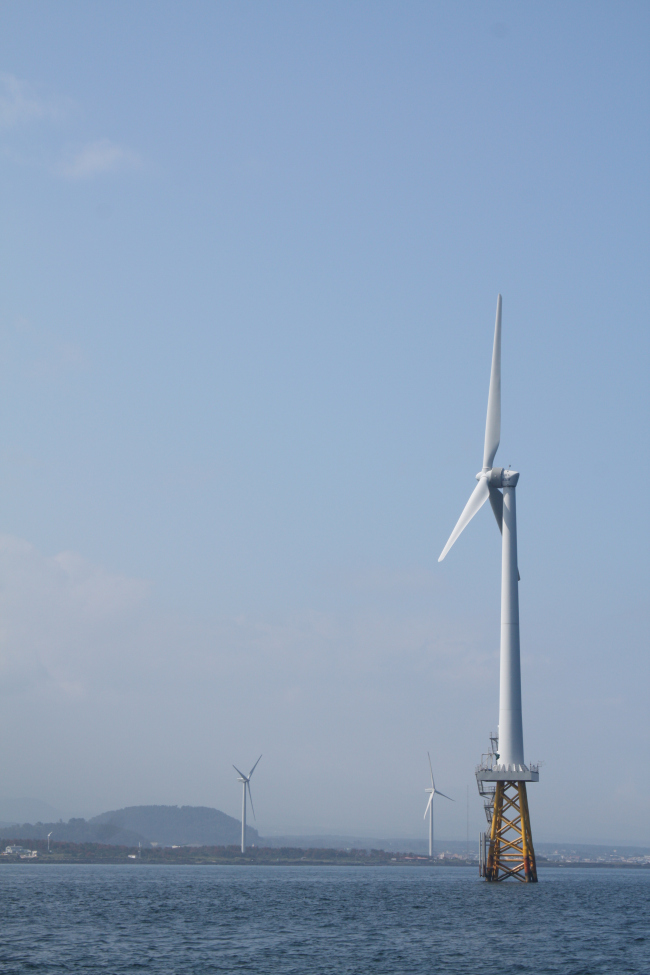JEJUDO ISLAND ― Korea’s wind power projects are moving toward offshore wind turbines, which have better wind speeds and weaker opposition from local residents.
The 2MW offshore wind turbine built near Jejudo Island was Korea’s first project developed by the state-run Korea Institute of Energy Research. If power is sold to the public, the 8-billion-won project ($7.4 million) is capable of generating enough energy for more than 700 households annually, the institute said.
Currently, the center has supplied its offshore wind energy to Korea Electric Power Corp. free of charge as the utility owner issues have not yet been fixed.
The 2MW offshore wind turbine built near Jejudo Island was Korea’s first project developed by the state-run Korea Institute of Energy Research. If power is sold to the public, the 8-billion-won project ($7.4 million) is capable of generating enough energy for more than 700 households annually, the institute said.
Currently, the center has supplied its offshore wind energy to Korea Electric Power Corp. free of charge as the utility owner issues have not yet been fixed.

With a 30-year lifespan, the wind turbine is 70 meters above sea level, has three 34-meter blades, and is approximately 1.3 km from shore. Power is delivered to land via a 2-km submarine cable.
The center also developed the world’s first beta type fixed steel jacket for the structure.
Though the jacket-type foundation was originally designed by a Norwegian company, KIER has developed its own low-cost, beta-type jackets.
“As Korea’s wind power industry is not as advanced as European countries, we lack the budget and infrastructure like support vessels. So we devised beta-type jackets which are easier to deliver from land and Korean shipbuilding companies already have expertise in,” said Kyung Nam-ho, head of the project at KIER said.
If Korea builds a 10GW offshore wind turbine complex with the technology, wind power will be able to cover 5 percent of the total electricity demand, he said. In 2010, the government set a target of increasing wind power to 12.6 percent of total energy demands by 2030.
For the next project, KIER is now attempting to push ahead with developing floating wind turbine technology. It is an offshore wind turbine mounted on a floating structure that allows the turbine to generate electricity in depths where bottom-mounted towers are not feasible.
“We have signed a memorandum of understanding with the Korea Advanced Institute of Science and Technology to carry out joint research to develop floating wind turbine technologies starting from next year,” KIER’s wind energy laboratory chief Jang Moon-seok said. “It will take some time for the commercialization but if the project goes well, this will be the first floating wind turbine in Korea.”
By Shin Ji-hye (shinjh@heraldcorp.com)
-
Articles by Korea Herald







![[Graphic News] More Koreans say they plan long-distance trips this year](http://res.heraldm.com/phpwas/restmb_idxmake.php?idx=644&simg=/content/image/2024/04/17/20240417050828_0.gif&u=)
![[KH Explains] Hyundai's full hybrid edge to pay off amid slow transition to pure EVs](http://res.heraldm.com/phpwas/restmb_idxmake.php?idx=644&simg=/content/image/2024/04/18/20240418050645_0.jpg&u=20240419100350)






![[From the Scene] Monks, Buddhists hail return of remains of Buddhas](http://res.heraldm.com/phpwas/restmb_idxmake.php?idx=652&simg=/content/image/2024/04/19/20240419050617_0.jpg&u=20240419175937)

![[KH Explains] Hyundai's full hybrid edge to pay off amid slow transition to pure EVs](http://res.heraldm.com/phpwas/restmb_idxmake.php?idx=652&simg=/content/image/2024/04/18/20240418050645_0.jpg&u=20240419100350)

![[Today’s K-pop] Illit drops debut single remix](http://res.heraldm.com/phpwas/restmb_idxmake.php?idx=642&simg=/content/image/2024/04/19/20240419050612_0.jpg&u=)